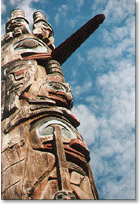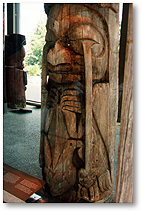Thunderbird Park
An Interview with Peter Macnair at Thunderbird Park, Victoria, B.C.
July 6, 1999
Between 1908 and 1912 and from 1928 through 1930, Emily Carr traveled to remote First Nations villages on Vancouver Island, Haida Gwaii (the Queen Charlotte Islands) and the Skeena and Nass Rivers to sketch villagescapes, totem poles, housefronts and canoes.
Today replicas of two totem poles Carr painted on these journeys stand in Thunderbird Park, Victoria. The replicas were carved by Kwakwaka'wakw Chief Mungo Martin and his associates Henry and Tony Hunt.
The purpose of the display in Thunderbird Park was to erect new poles that could withstand the weather while the old ones were preserved and maintained in a controlled atmosphere inside the B.C. Provincial Museum.
Haida Housefrontal Pole from T'anuu
This is a housefrontal pole which stood in the Haida village of T'anuu when Carr visited it early in the 20th century. She completed a watercolour sketch of this pole in its entirety. Later she created an oil painting which features important central figures on the pole. Prior to Carr's visit anthropologist John Swanton, with the assistance of C.F. Newcombe, photographed and mapped many Haida traditional villages and recorded the names of the community houses. They listed the crest figures carved on the housefrontal poles, mortuary poles, house poles and memorial poles. These photographs can be used to compare the state of the villages and poles at about the time Carr visited them.
 The figures on the very top are called Watchmen, they wear ringed, cylindrical hats and it is said that they are on watch and call out to the owner of the house when any enemy or danger approaches. Nearly all Haida housefrontal poles depict watchmen on the top. Usually there are three watchmen but some poles may have two or occasionally one. This replica pole was carved by Henry and Tony Hunt, the artistic successors of Chief Mungo Martin who founded the carving program here in Thunderbird Park about 1952.
The figures on the very top are called Watchmen, they wear ringed, cylindrical hats and it is said that they are on watch and call out to the owner of the house when any enemy or danger approaches. Nearly all Haida housefrontal poles depict watchmen on the top. Usually there are three watchmen but some poles may have two or occasionally one. This replica pole was carved by Henry and Tony Hunt, the artistic successors of Chief Mungo Martin who founded the carving program here in Thunderbird Park about 1952.
We won't deal with all the figures on this pole from T'anuu's but the most interesting one is the second main figure down which depicts a human creature whose eyes appear to be dangling from their sockets. They terminate in little human-like faces.
 Carr and others have popularly called this the "Weeping Pole" or the "Weeping Woman Pole" which is a misnomer. C.F. Newcombe recorded the story of this pole.
The main creature is a Sea Chief who resides on a rock near Bonilla Island on the central coast of what is now British Columbia. Every night, so it is said, his eyes fall out of their sockets and hang down the length of his body. In the morning his friends come by and pick up his eyeballs and place them back in his eyesockets. He has no teeth and he swallows his food whole; one of his favourite delicacies is hair seal (that may be a hair seal carved on the brow of the Sea Chief). He cannot chew them because he doesn't have teeth; later he spits out the undigested bones. A section of the original pole, showing the Sea Chief, the very one Carr painted at T'anuu, is on display nearby in the Royal B.C. Museum.
Carr and others have popularly called this the "Weeping Pole" or the "Weeping Woman Pole" which is a misnomer. C.F. Newcombe recorded the story of this pole.
The main creature is a Sea Chief who resides on a rock near Bonilla Island on the central coast of what is now British Columbia. Every night, so it is said, his eyes fall out of their sockets and hang down the length of his body. In the morning his friends come by and pick up his eyeballs and place them back in his eyesockets. He has no teeth and he swallows his food whole; one of his favourite delicacies is hair seal (that may be a hair seal carved on the brow of the Sea Chief). He cannot chew them because he doesn't have teeth; later he spits out the undigested bones. A section of the original pole, showing the Sea Chief, the very one Carr painted at T'anuu, is on display nearby in the Royal B.C. Museum.
The late Wilson Duff, Provincial Anthropologist, conducted a survey of totem poles on the Skeena River, Haida Gwaii and northern Vancouver Island in the 1950s. He contracted with people from Gitanyow village who allowed him to salvage four poles which were then brought down to Thunderbird Park in Victoria. Mungo Martin made replicas of them and one set stands in Thunderbird Park. Another set of replicas was sent to Gitanyow where they can been see today. The Museum of Anthropology at the University of British Columbia in Vancouver was also a partner in this totem pole survey and salvage; some poles are in the collection there.
On to Next Page
|

